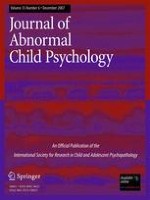01-12-2007
Maintenance of Treatment Gains: A Comparison of Enhanced, Standard, and Self-directed Triple P-Positive Parenting Program
Gepubliceerd in: Research on Child and Adolescent Psychopathology | Uitgave 6/2007
Log in om toegang te krijgenAbstract
This report describes the 3 year outcomes of three different variants of the Triple P-Positive Parenting Program, a behavioural family intervention. Families were randomly assigned to one of three intervention conditions or to a waitlist condition. At 1 year follow-up there were similar improvements on observational and self-report measures of preschooler disruptive behaviour for Enhanced, Standard and Self Directed variants of Triple P. At 3 year follow-up (completed by 139 families), each condition showed a similar level of maintenance of intervention effects. Approximately 2/3 of preschoolers who were clinically elevated on measures of disruptive behaviour at pre-intervention moved from the clinical to the non-clinical range. Across conditions, there was a comparable preventive effect for each intervention for these high risk children. The implications of the findings for the development of brief, cost effective parenting interventions within a public health framework are discussed.
